In this post, you will learn what is Manometer and how it works with Its Working principle, Applications, Advantages, Types of Manometers, and more.
What is Manometer?
The manometer is a device used to measure pressure at a point in a fluid via balancing the column of fluid by the same or another fluid. It is commonly known as a U-shaped tube that is filled with a liquid, gas, steam, etc.
In addition, you can use it as part of your laboratory experiment to indicate the air pressure on a liquid column. This is an instrument that measures air pressure using a container with”U”-shaped letter tubes open at one or both ends.
When air pressure is less than the gas pressure, the fluid height on the open side of the manometer will be higher. When the air pressure exceeds the gas pressure, the fluid height on the other side of the manometer will be lower.
Read Also: Different types of Flow Control Valves [Explained Their Working] PDF
Types of Manometer
Following are the three different types of manometers:
- Simple manometer
- Differential U-tube manometers
- Inverted U-tube manometer
- Inclined manometer
- Small manometer
Read also: Pressure Gauges: Types, Working, Applications and more
#1 Simple Manometer
A simple manometer has a glass tube that’s one end is connected to a point where pressure is to be measured and the other end remains open to the atmosphere.
The simple manometer is further classified into four types:
- Piezometer
- U-tube manometer
- For gauge pressure
- For vacuum pressure
- Single Column Manometer
- Inclined tube manometer or Sensitive Manometer
#1 Piezometer
For measuring the pressure inside a vessel or pipe in which liquid is there, a tube is attached to the walls of the container or pipe in which the liquid remains so liquid can rise in the tube. By determining the height to which liquid rises and using the relation p = ρgh, a gauge pressure of the liquid can be determined.
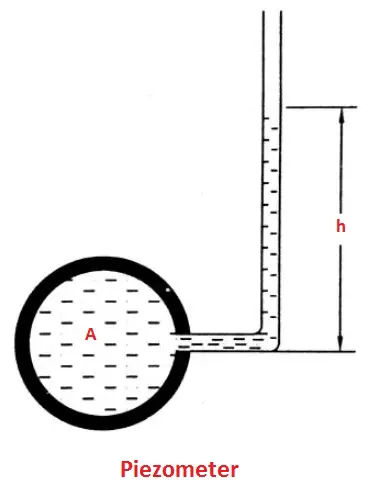
Such a device is known as Piezometer. To avoid capillary forces, a piezometer tube has to be about 1/2 inch or more. It is essential that the opening of the instrument be tangential to any fluid motion, otherwise, an incorrect reading will result.
Read also: Fluid: Properties of Fluids [Briefly Explained]
#2 U-tube Manometer
As shown in the figure it consists of a glass tube bent in V-shape, with one end is connected to a point at which pressure is to be measured and the other end remaining open to the atmosphere.
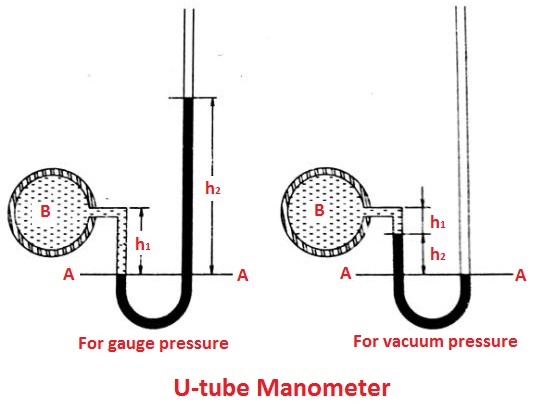
The tube carries mercury or any other liquid or fluid whose specific gravity is much higher than the specific gravity of the liquid whose pressure is to be measured.
- For gauge pressure
- For vacuum pressure
#3 Single Column Manometer
Consider a vertical tube micromanometer connected to a pipe containing light liquid under very high pressure. The pressure in the pipe will force the lighter liquid in the basin to push the heavier liquid downwards.
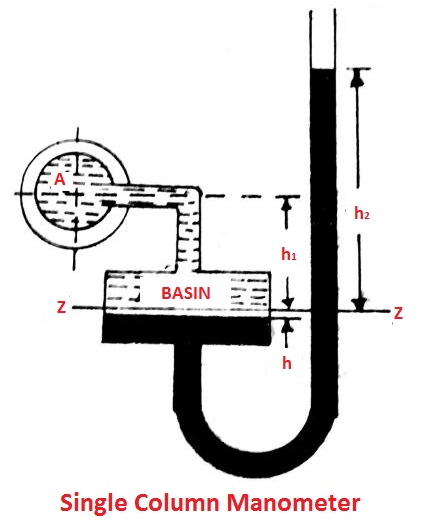
Due to the larger area of the basin, the fall of a heavy liquid level will be very small. This downward movement of heavy liquid into the basin will result in a significant rise of heavy liquid in the right limb.
#4 Inclined Tube Manometer
If the vertical tube of the micromanometer is made inclined as shown in the figure then it is called an inclined tube micromanometer.
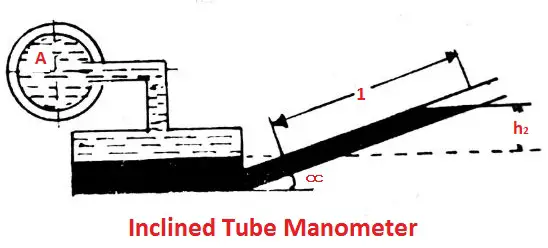
This type of inclined micromanometer is more sensitive than the vertical tube type. Due to inclination, the distance moved by the heavy liquid in the right limb is comparatively more. Thus it can give a higher reading for the given pressure.
Read also: What are the Applications of Pascal’s Law?
#2 Differential Manometer
The differential manometer is a device used to measure the pressure difference between two points in a pipe or in two different pipes.
A differential manometer consists of a U-tube, containing a heavy liquid, with two ends connected by points whose pressure difference is to be measured:
The differential manometer is further classified into three types:
- Two piezometer manometer
- U-tube differential manometer
- Inverted differential manometer
#1 Two Piezometer Manometer
It consists of two piezometers mounted at two different gauge points where the pressure difference is to be measured. The pressure difference between the two points can be simply measured by the difference in the level of liquid between the two tubes. It possesses some limitations in the form of piezometers.
#2 U-tube Differential Manometer
It is a device that is used to measure the pressure difference between two points in a pipe or between two different pipes. This manometer is consists of a U-shaped tube containing a heavy liquid.
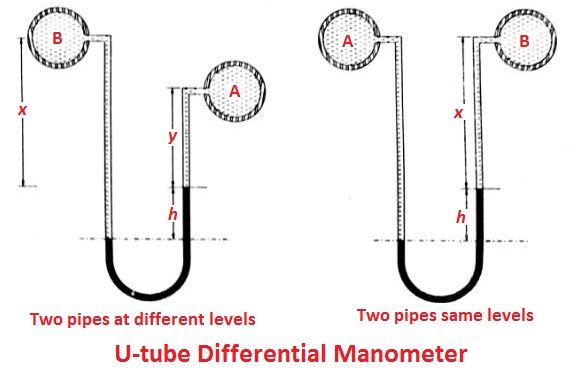
The two ends are connected to the two desired points in the pipe whose difference of pressure is required. Let pressure at point A be more than at point B. Then the greater pressure at A will force the heavy liquid in U-tube to move downwards. This downwards movement of the heavy liquid in the left limb will cause a corresponding rise of the heavy liquid in the right limb.
#3 Inverted Differential Manometer
In these types of manometers, the U-tube is inverted and contains a light liquid. The two ends of the tube are connected to the points whose pressure difference is to be measured.
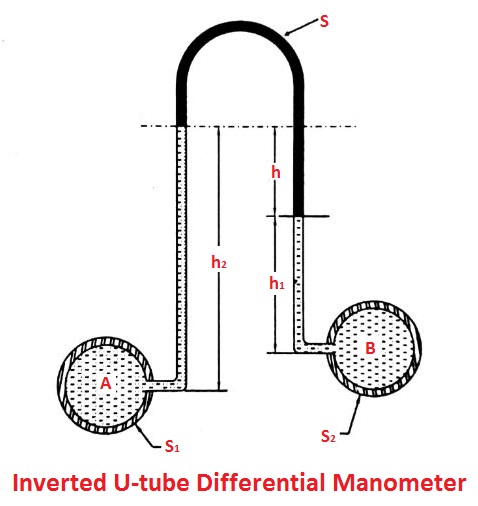
It is used for measuring the difference in low pressures. The figure shows an inverted U-tube a differential manometer connected to the two points A and B. Let the pressure at point A is more than the pressure at point B.
#3 Small Manometer
These are types of a manometer in that it works based on the principle of an inclined tube manometer. Small manometers or pressure gauges are used to measure very small pressure variations or very small pressure variations.
These manometers are also known as micro-manometer, which is a modified variant of a simple manometer whose part is formed by a large cross-sectional space. It is a highly precise instrument capable of observing very small pressure variations with high accuracy.
Advantages of Manometers
Following are the main advantages of manometer:
- It is simple to construct.
- It has great accuracy.
- Used to measure pressure, temperature, flow and other process variables.
Disadvantages of Manometers
Following are the main disadvantages of manometer:
- The manometer has a smaller dynamic response.
- They are fragile and therefore provide low portability.
- They have small operational limits which are on the order of 1000 kN/m2.
- The density of manometric fluid depends on temperature. Therefore errors may occur due to change in temperature.
Application of Manometers
Following are the main application of the manometer:
- Used in the maintenance of heating, ventilation and air conditioning (HVAC) systems, and gas systems.
- It is used to construct bridges, swimming pools and other engineering purposes.
- Used in climate forecasting.
- In clinical applications such as blood pressure measuring and physiotherapy.
FAQs
It is an instrument used to measure the fluid pressure at a point to balance a column of fluid by the same or another fluid. These are commonly referred to as U-shaped tubes.
1. Simple manometer
2. Differential U-tube manometer
3. Inverted U-tube manometer
4. Inclined manometer
5. Small manometer
Manometers are used in the maintenance of heating, ventilation, air conditioning (HVAC) systems, and gas systems. Also, they are used in climate forecasting.
Conclusion
That it, Thanks for reading, if you have any questions about “Types of Manometers” ask in the comments section. If you found this article helpful share it with your friends.
Want free PDFs sitting at home? Then subscribe to our newsletter.
Download PDF of this article:
You might like to read more in our blog:
exallent
Thanks.